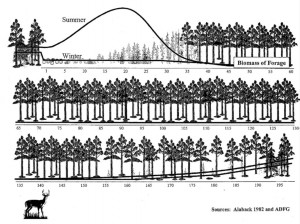Pictures and graphics are always important. In putting together a power point slide for an upcoming talk I am giving on the Tongass National Forest for the Oregon Museum of Science and Industry, I stumbled onto the following graphic representation (with lots of help from Gabe Scott our person in Cordova, Alaska).
Just a simple line drawing from a 30-plus year old study, but it says a lot that is relevant both for the Tongass and also as we look at options for O&C lands. My less-than-thousand-word encapsulation is as follows:
“If you clearcut fully-functioning winter habitat for coastal blacktail deer in the temperate forests of the Pacific Northwest, that habitat will not wholly function again as winter habitat until your great-great-great-great-grandchildren are old enough to hunt.“
I bring the above up because some in the hunting community are looking favorably on proposals to allow the timber industry freer rein on up to half of the O&C lands thus enabling more clearcutting and shorter rotation cycles in the 40-60 year range. Support for this concept within the deer hunting community springs from the notion that more clearcuts means more food for deer via emergent vegetation. And certainly this is true for summer forage but it also ignores the critical importance of quality winter habitat and a little concept known as Liebig’s Law of the Minimum. Hopefully, it is plain to those paying attention that those areas managed on these shorter rotations will never see fully functioning winter habitat for coastal deer. (Please look at the winter forage biomass curve on the above graphic for the years 0-60)
And we do not need additional studies or conferences to understand what this future could bring to our coastal deer populations, all we have to do is look at the correlation between clearcutting and deer population drops on Vancouver Island. Now certainly there are hunters there that blame wolves but they ignore the core importance of habitat.
Many hunters get this, but they need to be heard more broadly and the issues understood more deeply. Steven Rinella is a hunter who gets the implications of this potential management change. His words and the above graphic tell a compelling and potentially disturbing story.
To hear more about the O&C issues and others, please join us on August 26th from 6-8PM at the Eugene Public Library for a forum. Click below for details.
